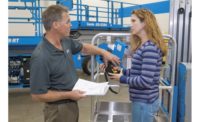Shooting Range Gets Safe & Sound-Proofed




To expand its training facilities, Western Technical College moved its shooting range from a classroom building to an existing well-built storage building on the school’s 160-acre campus near Sparta, Wis. Eliminating the frequent sound of gunfire in a classroom building and reducing sound leakage were among the primary reasons for moving the range. Panels were installed to absorb sound reverberation and reduce decibel (dB) levels inside the building while minimizing noise outside the facility.
The LEED Silver Certified Sparta Public Safety Training Facility consists of indoor and outdoor firing ranges and a forensic investigation laboratory. The multifaceted building was designed to provide scenario-based training and is available for rent. Extra-wide doors enable vehicles to be placed in the building, and alternating flashing lights can simulate traffic stop conditions in the shooting range. In addition to the college’s students, the shooting range is used by various agencies for training. More convenient to access than the range at nearby Ft. McCoy, the agencies renting the facility include U.S. Fish and Wildlife Service, Wisconsin Emergency Medical Services (EMS) and the Wisconsin Department of Natural Resources.
“We worked with Savage Range Systems to construct the indoor shooting range, and safety is always very important. Charles Nester of Savage Range Systems recommended using pinta’s SONEX Valueline Panels to absorb noise,” said Jay McHenry, director of facilities at Western Technical College. “Nester’s team is very experienced and can help facility managers and owners achieve their goals while saving money that can be used for other purposes.”
Savage Range Systems glued the panels to ¾-inch plywood sheets in overhead containment baffles that consist of the plywood, an air gap and AR5000 steel, a high-carbon, abrasion-resistant steel alloy. The baffles protect the building from ricocheting bullet. A bullet can go through the foam, but not the steel; the baffle will capture any deflected bullet that hasn’t found its way to the front of the range.
Water-based acoustic adhesive was used to install the panels to the plywood. The baffles hang from chains that are attached to trusses, and were installed starting about three feet from the firing position, then spaced out down the range. The acoustic material absorbs sound energy and reduces the reverberation time of sound within the building, lowering the dB level inside the range as well as outdoors.
“People in higher education like to share their observations and concerns, but I can honestly say there have been no complaints or concerns about noise regarding the Public Training Facility,” McHenry says. “Of course, people using the shooting range still use high-performance hearing protection. Outside the building, you can hear ‘pop, pop, pop’ as handguns and rifles up to .223 caliber are fired, but it’s not at the level of an alarming sound.”
Sound produced by gunfire is deafening outdoors, and when the acoustical energy it produces is confined to a small indoor space such as a firing range, it gets even louder. The noise can reach levels as much as 10 times greater than those experienced in outdoor ranges.
A surprisingly small number of acoustical panels go a long way in most shooting ranges. Typically, a range requires an amount of foam equal to the square footage of its ceiling. The foam is divided between the ceiling and walls for the most efficient sound absorption. This will normally reduce the amount of acoustical energy in the range by an amazing 85 percent.
Part of managing acoustics includes good construction of the walls, ceiling, conduit, and the heating, ventilation and air conditioning (HVAC) system. McHenry upgraded the building’s HVAC system to capture smoke and lead dust.
Looking for a reprint of this article?
From high-res PDFs to custom plaques, order your copy today!









